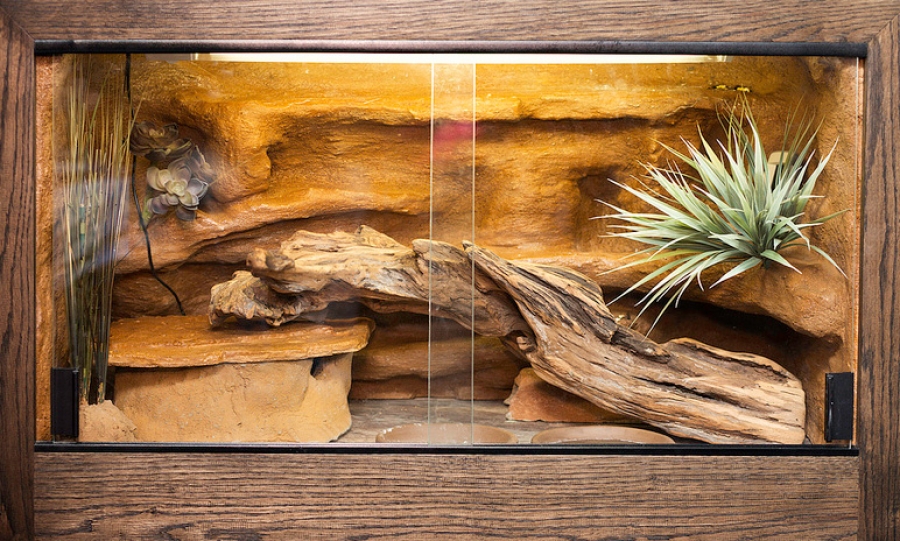
Image from leopardgeckocare.net
In this article you’re going to learn about leopard gecko habitats and everything you need to do to setup their enclosure.
Don’t get me wrong leopard geckos are one of the easiest lizards to take care of. However, if you own one of these little lizards you want to make sure you’re taking care of them properly. You do want your leopard gecko to feel safe don’t you?
In order to do this properly you are going to have to set their habitat up to be like their natural habitat in the wild.
We really hope you love the products we recommend as much as we do. But just so you know, we may receive a small share of the purchase price if you do buy as a result of following a link on this page. It doesn’t change our opinion or the price you pay. But it does help us keep the site up and running 🙂
Leopard Gecko Tank Setup
Leopard geckos do not climb so you don’t need to worry about getting them a vertical tank like you would with crested geckos, anoles, and chameleons. Instead a horizontal tank is ideal for housing your leopard gecko. I would suggest that you use a glass tank because they hold heat and look better than plastic tanks.
Don’t make the mistake of using a mesh cage, because they do not hold the heat in very well, and your leopard gecko could easily escape from a mesh cage. Also, they could end up cutting themselves on the mesh.
Tank Covers & Lids
You don’t want your little gecko to escape so you will need to get a lid. For lids I recommend that you get a wire/mesh top. This will also keep crickets or food from getting loose and roaming your house. The mesh covers are good for putting lights on, too. I also like them because I can spray the top of the cage with a water bottle so that my leopard geckos can drink water.
Solid lids will also keep the humidity levels up which leopard geckos really don’t need. I’m not a fan of glass or plastic covers. Just make sure you do get a lid because from my personal experience finding a leopard gecko once it escapes isn’t fun. Speedy has escaped 3 times and it always takes a while to get her back.
Tank Sizes
You need to give your leos some room to move around. Also be very clear that you know what you are doing if you decide to have more than 1 gecko. They are quite happy on their own in one tank. So don’t think you have to give them a friend to hang out with. This could even be a really bad idea – as 2 males will generally not get on at all, so you should never put more than 1 male in the same tank. You can have a male and female, but learn about breeding first. More than one female is usually OK.
These are the absolute minimum tank sizes I would recommend:-
- 1 Gecko – 10 Gallon
- 2 Geckos – 15 Gallon
- 3 or 4 Geckos – 20 Gallons
And even then – 10 gallons is very small, and really only a temporary measure for hatchlings rather than a full grown gecko. You can read more about leopard gecko tank sizes and also find some of the best gecko tanks here.
Leopard Gecko Lighting
Leopard geckos live in the middle east where the daylight changes from winter to summer. You can read more about the origin of them here or their common behaviors. Honestly, I don’t ever really change their hours though. In the summer they should have 14 hours of light and 10 hours of darkness. Then in the winter they can have 12 hours of light and 12 hours of darkness. It’s a good idea to get a timer for your leopard geckos habitat.
You do NOT need to get a UV light for your leopard gecko. I know a lot of kits at Petsmart and Petco sell them in kits, but leopard geckos do not require UV lights. In fact, if they are exposed to UV lights to often it actually stresses them out.
Daytime Lights
Since you want to simulate the day and night you are going to need a light – don’t just rely on light from a window, it’s often not enough inside a house. You can get a reptile dome for pretty cheap and then use a standard 60 watt light bulb in it. You could optionally also get a heat lamp for your leopard gecko. However, your leopard gecko will usually never bask in the light since they are burrowers and not basking lizards. Also read more about temperature below.
Nighttime Lights
You have a couple options when it comes to purchasing lights for the nighttime. You can either get a blacklight (UV) or infra-red light. Both of these lights will work fine. It’s really just a personal preference. You don’t even need to buy a special black or red light for reptiles – just don’t get anything high powered.
If you really don’t want to purchase a nighttime light you don’t have to either – it’s just a good idea to do if you want to actually see your leopard gecko when they are out at night (remember, they are nocturnal creatures!).
Temperature
 Leopard geckos are cold blooded reptiles. This means that they absorb heat from the environment. The temperature for your leopard geckos tank needs to be the right temperature. Too hot or too cold and your leopard gecko can become stressed, and could ultimately die. It’s really useful therefore to have a couple of thermometers, ideally electronic ones as these can also tell you what the maximum and minimum temperatures have been over the last 24 hours.
Leopard geckos are cold blooded reptiles. This means that they absorb heat from the environment. The temperature for your leopard geckos tank needs to be the right temperature. Too hot or too cold and your leopard gecko can become stressed, and could ultimately die. It’s really useful therefore to have a couple of thermometers, ideally electronic ones as these can also tell you what the maximum and minimum temperatures have been over the last 24 hours.
There are three areas of your tank that you need to adjust the temperature of the tank. To do this you can either put heated ceramic emitters or heated rocks in their enclosure.
Daytime Temperature
Different areas of their habitat or cage should be different temperatures. The hot side should be between 87 and 90 degrees. This is important to make sure your leopard geckos are digesting their food correctly. The cooler side of their habitat or cage can be between 74 and 80 degrees. I wouldn’t recommend having their habitat any hotter than 94 degrees. Otherwise your leopard gecko could get too hot.
Nighttime Temperature
Since leopard geckos are nocturnal they come out at nighttime. Often times you will find your gecko sitting on a warm rock. I do use heated rocks which my leopard geckos love. But, the night time temperature should be cooler than the daytime temperature. It should be between 70 and 75 degrees.
Humidity
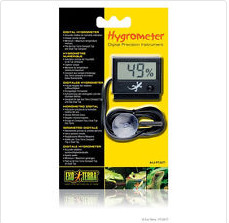 Humidity is a very important factor you should consider when taking care of a leopard gecko. Without the proper humidity your gecko could have difficulty shedding, have problems with hydration or can even get infections.
Humidity is a very important factor you should consider when taking care of a leopard gecko. Without the proper humidity your gecko could have difficulty shedding, have problems with hydration or can even get infections.
Ideally, your leopard gecko’s tank needs to be between 20% and 40%. If you are concerned about the humidity level of the tank you can always purchase a ‘hygrometer’ which will give you a readout of the humidity. One common way to reduce the humidity is to increase the airflow in the tank. This can usually be solved by getting a mesh lid. However, if the humidity is too low you might want to put some moist moss in the tank or possibly put a small or large water dish in there.
Leopard Gecko Substrate
Your substrate for your leopard gecko is the flooring on their tank. Owners do tend to like various different substrates for their leopard geckos. I have used most of them over the years and can tell you a little bit about each one of them.
Sand
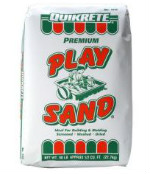 I used washed play sand that I get at Home Depot. You can get 50 lbs of sand for 5-6 dollars. Do not use sand if your leopard gecko is a baby though. I wait until they are full grown before changing their substrate to sand. The reason being is because leopard geckos can eat the sand when hunting, and get ‘impacted’ and die.
I used washed play sand that I get at Home Depot. You can get 50 lbs of sand for 5-6 dollars. Do not use sand if your leopard gecko is a baby though. I wait until they are full grown before changing their substrate to sand. The reason being is because leopard geckos can eat the sand when hunting, and get ‘impacted’ and die.
You can read more about sand here. Some owners have very strong views about not using sand at all, so if you’re at all concerned you can just avoid it and use something else.
Tiles
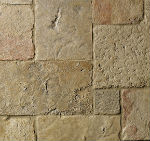 I have used tiles over the years and they are pretty easy to work with. There is no risk for impaction and leopard geckos really do like the tile substrate.
I have used tiles over the years and they are pretty easy to work with. There is no risk for impaction and leopard geckos really do like the tile substrate.
However, the bottom of your tank is glass so make sure you don’t drop the tile in there or you could crack the glass or break your tile. I would recommend putting reptile carpet under it or some newspapers or paper towels.
Newspapers/Paper Towels
You can use newspapers or paper towels. These are easy to clean, and you can easily throw them out when you’re done using them. They don’t look the most appealing, but if you’re on a tight budget, you can definitely use them.
Reptile Carpet
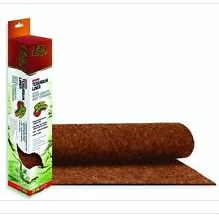 I tend to use reptile carpet when my leopard geckos are babies.
I tend to use reptile carpet when my leopard geckos are babies.
Reptile carpet is easy to clean and either comes in green or brown (you can get it here). The only downside to reptile carpet is that you do have to take the whole thing out and clean it every week or so — or it will begin to smell.
I wouldn’t use a piece of regular carpet though. This reptile carpet stuff is much thinner and a lot easier to use than regular carpet. I made the mistake of trying to use regular carpet a couple of years ago.
Leopard Gecko Hides
Hides are very important for your leopard gecko. This is where they are going to spend their day. Leopard geckos are burrowers by nature and are usually hiding 90-95% of the time. This makes them feel safe and secure.
There are three different types of hides that leopard geckos should have:-
Warm Hide
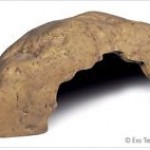 This hide is placed on the warm side of the tank. The point of a warm hide is to help the gecko digest their food.
This hide is placed on the warm side of the tank. The point of a warm hide is to help the gecko digest their food.
Also, if your leopard gecko is too cold they will go over to their warm hide to help their bodies warm up again.
You can find warm hides on eBay here.
Cool Hide
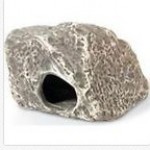 Obviously, the cool (or cold) hide does the opposite of the warm hide. When your leopard gecko gets too warm they will go into the cool hide.
Obviously, the cool (or cold) hide does the opposite of the warm hide. When your leopard gecko gets too warm they will go into the cool hide.
I think it’s a really good idea to have one of these hides.
You can find cold hides on eBay here.
Moist Hide
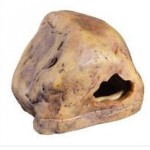 The moist hide, or sometimes called the humid hide, is where your leopard gecko will go when they are shedding. These hides have a higher humidity and should have a wet paper towel in them. This helps your gecko shed their skin whenever it’s time for them to shed. It is a good idea to spray the moist hide at least once every couple days.
The moist hide, or sometimes called the humid hide, is where your leopard gecko will go when they are shedding. These hides have a higher humidity and should have a wet paper towel in them. This helps your gecko shed their skin whenever it’s time for them to shed. It is a good idea to spray the moist hide at least once every couple days.
You can find moist hides on eBay here.
Also check out our essential checklist for setting up a leopard gecko habitat.
Leopard Gecko Decor
It’s always a good idea to add some plants, rocks, background, etc. to your tank. This is great to help dress it up but also gives the gecko something to crawl around on. You want your gecko to feel safe and at home right? Then you should consider purchasing a few extras for their tank.
Plants
Plants are great for your geckos. You can either get real plants or artificial plants. As mentioned in my leopard gecko feeding guide you have learned that they do not eat vegetables, so unlike bearded dragons or other lizards, you don’t have to worry about them eating any plants you decide to drop in their tank. I should note that live plants are going to look a lot better than artificial plants, but live plants will raise the humidity in the tank.
Rocks/Logs
Leopard geckos love to climb rocks, logs, and limbs whenever they do come out at night. It’s a great idea to get them some rocks or limbs to explore at night. I have a long vertical cave that my geckos love to climb and sit on top of at night. Just be sure that anything you bring from outside has no parasites on it. You can heat them up at a low temperature to kill anything that might be on them before placing them into the tank.
Backgrounds
Don’t make the mistake of not using a background for your leopard geckos – it make a huge difference to how awesome your tank looks. Pick out a nice background for your gecko – it will look greta and help them feel safe and secure.
Honestly, there are lots and lots of backgrounds you can choose from, and they are pretty cheap. I don’t like going to Petsmart or Petco for these because they only have a limited range of backgrounds to choose from. Instead I like to go on eBay where you can get a custom one.
Bowls
It’s not vital that you have a water bowl for your leopard gecko. I tend to just spray the tank at night with a spray bottle. They love to come out and lick the rocks and get their water that way.
However, if you want you can buy a water bowl. Just make sure it’s a shallow one so they can’t get trapped in it and drown. However, I do recommend food bowls for mealworms and superworms as this keeps them from crawling away.

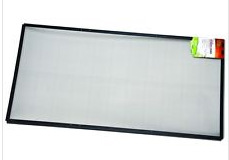
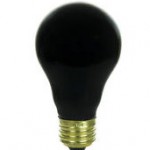
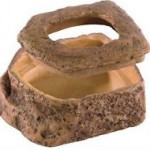
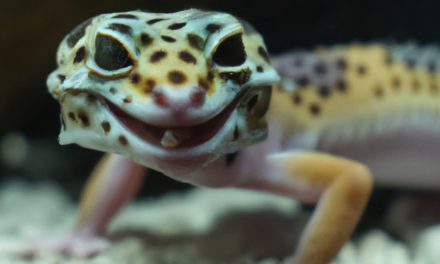
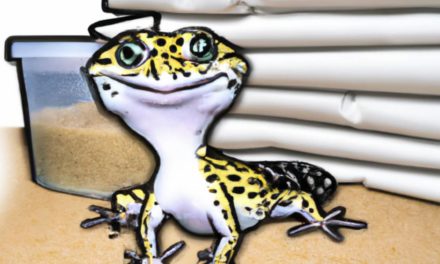
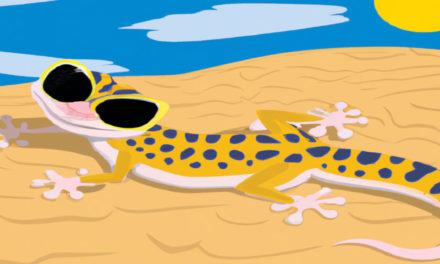
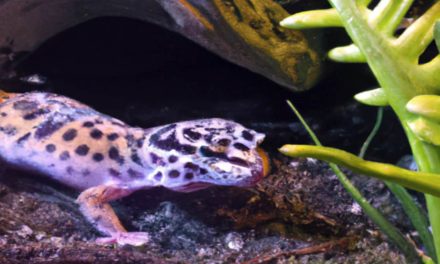










Hey, I just got a leopard gecko a few days ago, I believe I am going to change the floor, what I mean is I have a sand mat down currently, I am going to change it and replace it with paper towels, I am also going to purchase more things for it. Can you please tell me how I should remove it from it’s terrarium, it’s a baby, and it doesn’t like me.
One of my brothers bought his kid a gecko, and we are looking for ways to decorate the tank. It was great you said to add plants and rocks to gives the gecko something to crawl around on. While he gets the reptile, I will find what he will need for the tank.
My adult leopard gecko shed about 3 day ago yet he/she still has a patch of skin covering its’ right eye. How or should I help remove it? Thanks for all the information.
You should help it out, leaving stuck shed can lead to loss of limbs. Your leo probably won’t like it, but it’s for the best. Try to get the skin moist first, by spraying it with water or gently using a sponge.
I too am having that problem please tell me if you were able to get it off and how?
We put ours in a bowl with shallow warm water & use a wet washcloth to help her out of any shed that didn’t come off. When I see that she looks like she will shed soon I have a spray bottle that I spray into the tank a few times a day.
Hi! We just got a Leopard Gecko. We have the day light and the night light. However when we have the nightlight on the temperature in the tank is going up well over 90 degrees. How do we use this light system and maintain the proper temperature. We just got the little guy, and I am at a loss on what to do. Any help would be appreciated.
Well done for monitoring your temperatures to actually know that it was getting too hot 🙂
Check how high/low the temperature of the actual room gets at night – depending on the time of year you may not need any additional heat source at night. Alternatively you may need a lower powered bulb or your tank may be too small (so would heat up fast from even a lower powered bulb).
Using heat lamps really isn’t a good idea- a heat mat is much better, as leos absorb heat from their stomachs, and do not bask. Heat lamps can also lead to blindness.
What do you think is the best way to maintain the temperature in a 95 gallon tank?
There are lots of opinions and ways to do it. Heat lamps, regular lamps, under tank heat mats, heat tape – all of which can work just fine.
But you also need to think about where the tank is located. What are the room temperatures, how do they vary from Summer to Winter, is the tank near a window where it may get cold draughts sometimes or direct sunshine, is it near a radiator or AC unit etc. So you need to get the right ‘power’ of heating for your situation as well as tank size.
The key really though is regularly monitoring your temperatures so you know when you’ve got it right, and when you need to make adjustments.
I have a 95 gallon tank – can I use it for a leopard gecko? If so how many can I put in it?
That’s a good size tank, so you could have more than one, but there’s no need to. Also read more about minimum tank sizes and keeping more than one gecko here.
Thank you so much for this site. We just bought our daughter a leopard gecko – 20 gallon tank. She is allergic to everything but not him. Your site told us to get more places to climb and a cold place to hide.
I have a 80 gallon tank for my leopard geckos. What size UTH do I need?
Leopard Gecko Land, nice job bro, really informative website, love it. I love leopard geckos, they’re so cool. I asked my parents if I can have one and they said no, but I’ll get one when I’m older. I got a question though, what thing will you recommend me to use to know the temperature and humidity in the gecko’s tank? Also thx for all this info, now I know what I need for my gecko’s habitat/home.
I have a leopard gecko and about a 20 gallon tank recently just got him about four months ago. And I just started using the correct sand In his tank. But I noticed when I was feeding him that while he was eating the crickets he was also eating some sand. And I’ve done some research but all the research I am doing it is going back-and-forth with negative and positive comments. So definitely confusing. So I was reaching out to anyone that is using sand for their gecko to give me some advice and to let me know if there gecko is doing fine with the sand. And a Nother quick question I was suggested to put some sort of moss in one of his hiding spots. Is that correct and is that something I should do. And thank you for whoever took the time to read this and reply back to me.
You could add moss to help with the shedding, but make sure not to spray it if you already have wet paper towels in your hide 🙂
Hi
My son has a leopard gecko. I want to move him to a bigger tank. I want to know if I have a small heat pad and a light will it be OK? Of course we will control the temperature. At the moment he is in a small tank and the one heat pad seems to be working fine.
Hello I was wondering, I am planning on getting a 10-gallon tank and putting all the decorations in and I was wondering what do you do with the cord for the heated rocks? I don’t want it to be easy to see because that would ruined the illusion of the terrarium being someplace in the wild. Thanks!!
Great article! What type of heated rocks do you use and prefer? Any specific brand I should keep my eye out for?
Where can I purchase the tiles for the bottom of the tank for my Leopard Geckos?
So a few hours ago I added some things to my baby’s home, a humid hide (with a wet paper towel) and a bigger water bowl. The only things I kept were the rocks she stands on and her favorite log to lay under. I was just wondering if it would shock her that everything has changed so suddenly? I just want her to be happy and safe.
Hello!
My fiancée and I just rehomed a not-so-tame leopard gecko that was a classroom pet. He isn’t per se skittish, but he is pretty cautious.
He spends nearly all of his time in a rock hiding and we just want to extra sure we are doing everything alright instead of missing something vital.
Give him some time to get used to his surroundings again. He should be sleeping in his rock during the day. It’s very normal for leopard geckos. They come out at night and sit on rocks.
Thanks a lot for writing this. I was confused on the tank size I should get for my leopard gecko. I did just buy a 10-gallon one off Craigslist for $10. A good place to buy reptile enclosures.
Great site
Lots of useful info and very interesting – I never realised how much you can do with geckos.
Best Regards,
Paul
Hi. I just got three leopard geckos for my kids.I’m not sure if they’re female or male. How can I tell. Now I bought the all inclusive tank with the heated lamp, should I take that off? I will be back with more questions.
Congratulations on buying your leopard geckos!
I wrote an article on determining if they are male or female.
You probably don’t need the heated lamp. I tend to lean towards heated rocks with no lamp.
Petco sold me a UVB light for my leopard gecko. I feel so duped! I guess I don’t need one right?
Yep, take it back you don’t need one. I hope you have a receipt.
It’s really important on making a domestic animal comfortable at home. And this site tell’s me exactly what to do if I ever wanted to get a gecko at home. But, I do have a question. Someone told me that leopard geckos need UV lighting. Is that correct?
Totally false. They don’t need UV lighting.
Can two females be housed together or two males. I just bought a high yellow leopard gecko and believe it’s a girl, but I wanted to make sure I can put them together before buying another gecko.
Two females can be housed together. About 99% of the time they will get along. However, you shouldn’t ever house two males together otherwise they will fight.
Hi Garen,
What a fun site you have here! Especially for all those Gecko fans! I am going to pass this site on to my grandson. He has one or two geckos. I am sure he will enjoy all the info. you have here. Keep up the good work!
Julie
Hi, informative article thanks! I’m just wondering, whilst the habitat will be heated to ideally maintain a correct temperature, is this always possible to keep them cool in a very hot climate, even with the cool-hide?
I live in Australia..the hot part!..is there any instances in which it could get too hot, and the poor little gecko could get over-heated?
Yes, leopard geckos can get to hot and die. Generally, if it gets hotter than 94 it becomes unsafe for them. This is the reason they sleep during the day in their hides (and to stay out of the eyes of predators). The hides block the heat from getting to them. The further they burrow down the cooler they will get. Their cold hide can’t really get to hot because of the material it’s made out of.
Thanks for sharing the perfect habitat for a leopard gecko.
I have gone through your list to make sure my son’s pet Mordecai has the perfect habitat.
We just have one hide that is warm for Mordecai, do you suggest that we should get a couple more hides, a cool and a moist hide for him?
We also use a heat lamp for light and heat and use a red night light for him. I didn’t know that a regular bulb would suffice- it’s a lot cheaper to buy a regular bulb.
We use sand for as his substrate, how often should we change the sand?
Thanks!
Yes, it wouldn’t hurt to add a couple more hides. I would at least get a see through hide so you can see your leopard gecko at all times. My 4 leopard geckos love them and you can see them passed out there all day long. I would recommend changing your sand every couple months or so.
Thank you for the quick reply. I will get a couple more hides and then Mordecai will have the perfect habitat! 🙂